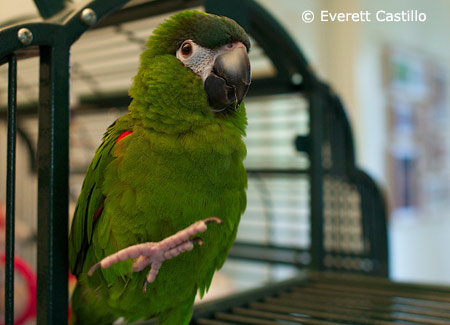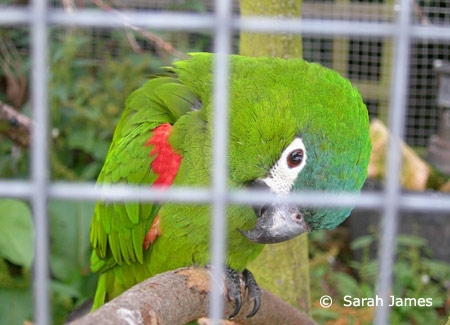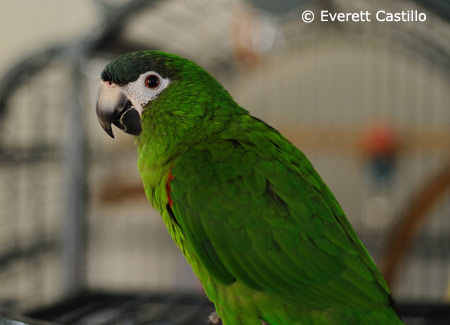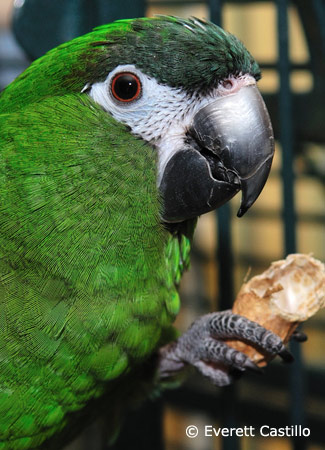[bars]
Common Names: Red Shouldered Macaw, Mini Macaw, Han’s Macaw, Hahn’s Macaw
Scientific Name: Diopsittaca nobilis
Origin: Venezuela, Guianas, Colivia, Brazil, Peru
Relative Size: 14 inches
Weight: 165-175 grams
Average Lifespan: 30-50 years
Egg Clutch: 3-4 white eggs
Incubation: 24-26 days
Talking Ability: Excellent
General Information about The Hahn’s Macaw

The Hahn’s Macaw is one of three red-shouldered macaws kept as a pet throughout many households. Another well known species is the Noble Macaw. These birds look very similar in that the average person might find it difficult to tell the difference between the two species.
The most obvious difference between the two macaws can be seen in the parrot’s beak. Hanhn’s Macaws have upper beige and black colored beaks while the Noble Macaw has a solid beige upper beak. Not only is color a way to distinguish between these two similar species, but the size of the beak is also a variable. The Hahn’s macaw has the smaller beak of the two. In addition, most Hahn’s Macaws are slightly smaller than Noble Macaws.
These mini macaws are green with olive green highlights throughout their bodies. As young juveniles, these birds leave the nest with only a solid green color. Once the bird goes through its first molt, red feathers will begin to appear underneath their wings. The red becomes so prominent that the bird appears as if it has red shoulders; hence, these parrots are named red-shouldered macaws.
[ads]
Adult Hahn’s Macaws will develop a blue cap that can be seen only upon maturity. Like all macaws they have white skin that surrounds their eyes. Their eyes are a glossy fiery orange with a tiny black pupil. When these birds are in flight more hues of darker greens, olive greens, bright reds, and yellows can be seen.
These parrots are about 12 to 14 inches in length and the tail is as long as the bird itself. These parrots are relatively small and about the size of a Sun Conure bird.
They have black scaly feet that are relatively large compared to their bodies, which can give them an odd appearance. Their feet have two toes pointed forward and two toes pointed backwards. This foot shape is ideal for climbing and manipulating objects within their environment.
Hahn’s Macaws in the Wild
True beauty is to see a Hahn’s Macaw in its natural wild habitat. Since most of us don’t get this opportunity, we end up getting one as a pet. There is nothing more spectacular than seeing this wild bird in green foliage settings with its vibrant colors glistening against natural surroundings. These parrots are most at home in the lowlands of the rainforest or thrive in swampy areas.
These social parrots are quite comfortable around other South American birds such as Sun Conures, Pionus Parrots, and Amazons. Though these parrots tend to form smaller flocks, many can sometimes be seen gathering and foraging with other birds while removing clay from clay licks (cliffs). It is believed this clay helps remove toxins the bird consumes while foraging for fruits within its environment.
In the wild, these birds will feed on flower buds, berries, fruits, an occasional insect, nuts, and seeds. A great deal of their time is spent looking for food, mainly in the morning and late noon. Bathing, playing, preening, and chewing are not uncommon behaviors as well.
Hahn’s Macaws in Captivity

Hahn’s Macaws have been kept in captivity for hundreds of years. These parrots have been kept by natives and explorers for their talking ability and friendly demeanor. Though exporting and trapping of these parrots has been minimized to a large extent, these parrots remain endangered due to habitat destruction.
At one time, these parrots were imported freely throughout the world due to no regulations or laws regulating the trapping and import of these parrots. It was not until it was placed on the list of the Convention for International Trade in Endangered Species (CITIES) did the illegal trappings curtail. Before this law came into practice, many birds were taken as babies from the wild and placed into wooden crates without too much concern for their welfare. A lot of baby Hahn’s Macaws were barely kept alive as the overall goal of a trapper was to rid the chick in exchange for money as soon as possible. As a result of this negligence, many of the baby parrots were malnourished, abused, and died.
Hahn’s Macaws are much more popular in captivity compared to their close cousin the Noble Macaw. These birds are not that difficult to find in the pet trade. Most can be found at a local bird show, with a local breeder, or can be bought through classified ads.
There are many great breeders who go to great lengths to ensure these birds remain healthy and happy in captivity. Many Hahn’s Macaw breeders will allow their parrot pairs to raise a few of their young as they make wonderful breeders as adults. A Hahn’s Macaw that has been tamed and imprinted on humans will probably never breed successfully. So for this reason the best Hahn’s Macaw breeders do not allow the parrots too get too tamed.
A Hahn’s Macaw as a Pet

Owning a Hahn’s Macaw has many benefits. Though they are much smaller than their larger macaw cousins, they do have larger parrot personalities in general. The major benefit of owning a Hahn’s Macaw compared to a larger macaw is that you don’t need to have such a large cage and these parrots tend to be less noisy. For this reason, it is highly recommended that a new bird owner look into this species before looking into purchasing larger macaws.
These mini macaws are gentile parrots if properly socialized and acquired from an early age. The best Hahn’s Macaw is one who has been handfed and has constantly interacted with people on a daily basis.
These birds do not cope with being left alone for long periods of time. Like most parrots, if these birds are neglected many will resort to phobic behavior such as plucking their feathers or even self mutilation with their beaks.
Hahn’s Macaws are wonderful talkers if handled properly and purchased at an early age. Most macaws might learn a few words, but the Hahn’s Macaw and Noble Macaw seem to be much more gifted when it comes to taking. Both males and females are able to talk and their speech is often described as high pitched and clear. If an owner wishes to encourage their parrot to start speaking, it is important the owner encourage it by repeating phrases and words in an excited voice. They tend to pick up on female voices as most are high pitched.
It should also be noted that not all parrots learn to talk. For this reason, a parrot should never be purchased on this merit alone. An owner may be disappointed if the parrot doesn’t pick up words. All parrots should be purchased for their personality traits and talking should be looked upon only as an extra perk.
These parrots are also playful and very curious creatures. When they are younger, most owners often report that it is difficult keeping their parrots stationary. As the bird matures, it will calm down and enjoy spending countless hours on their owner’s shoulders. These tiny macaws also enjoy climbing inside their owner’s clothing as this provides warmth and security.
These parrots should be taught tricks as this keeps their minds active. These intelligent parrots should be taught new tricks throughout their lives so that they don’t get bored. They can be taught to turn around, wave, lift their wings ups, or to talk on command. The tricks to be taught are endless. The more tricks the parrot learns, the more the owner and bird will bond.
Hahn’s Macaw Nippiness and Screaming
Sometimes baby parrots become a bit nippy after they have just weaned. Many owners find this devastating as they believe their parrot will remain nippy forever. This is only a temporary stage and the best remedy is to completely ignore this behavior. If the bird should bite, the owner should simply move their hand back and continue handling the bird without reacting. No reprimands or punishments should be given to the bird because a parrot doesn’t understand this is a form of punishment, but rather as a form of getting an owner’s attention. Simply ignore all unwanted behavior and this stage will soon pass.
Another problem that owners report is the amount of noise these parrots make. Though they are not known to make persistent calls like a Sun Conure, they can be loud when they squawk. For this reason, it is not recommended to have a Hahn’s Macaw in an apartment setting. Many Hahn’s Macaw owners will train their macaws to talk rather than scream, but this can take time.
To help minimize excessive squawking ignore your bird altogether if this should occur. Instead, begin by praising and rewarding the bird when it’s in a quiet mode. Overtime, the macaw will change its behavior and it will begin to understand that it will only get attention when it is not squawking or screaming. With that being said, the owner should expect the macaw to scream during the early morning hours, late noon, and before bedtime as this is what they naturally do in the wild.
Breeding Hahn’s Macaws
Breeding a Hahn’s Macaw is not too difficult. Many breeders have a great deal of success breeding their pairs, and once bonded, many become prolific breeders. The best stock for breeding is usually a Hahn’s Macaw that has been bred inside an aviary. Many owners report that an extremely tame bird rarely produces successfully. They tend to run into complications such as infertile eggs, improper incubation, and starvation of their chicks.
These macaws tend to breed in the warmer months of summer. For this reason, precaution should be used as the chicks can easily overheat if the temperature is too hot. All cages should be protected from the sun and air should flow freely through the cages as this will prevent the parrots from overheating and they can then breed successfully.
These mini macaws do not need large spaces to produce successfully. A cage that is about three feet in length, three feet in width, and four feet in height will do just perfectly. The cage should have several steady perches to ensure the birds are able to successfully mate. In addition, it’s important to have food bowls with extra fruits and vegetables, a large rectangular shaped nesting box, and a barrier to ensure other birds cannot see each other during the breeding season.
Many owners find that their Hahn’s Macaws breed best when they hear other macaws but do not actually see them. For this reason, every cage should have a barrier to ensure the birds do not see their neighbors or interact with them.
Once the pairs have successfully mated, the female will lay between three or four white eggs. She will incubate them for approximately 24-26 days. Once the chicks hatch, they will grow rapidly and fledge around seven to eight weeks. Weaning is around 10 weeks. Some chick may take a few weeks longer if they are housed alone.
Choosing a Cage for a Hahn’s Macaw
Hahn’s Macaws need larger cages considering they are conure-sized parrots. These birds are acrobatic and require room to swing, flap their wings, and climb. These parrots should be housed in a cage about three feet in width, length, and height.
Safety should be a priority when choosing a cage because some cages may be harmful to a Hahn’s Macaw. For example, it would be unwise to select a cage whereby a parrot can stick its head through the bars. This would cause the parrot to possibly get its head stuck. Also, the cage should be zinc free and rust resistant. The optimal choice would be to have a cage that is powder coated. In this way, it allows the cage to be cleaned weekly without causing too much wear and tear and damage.
Though a well made cage can be costly, it is more costly buying two or three cages throughout the bird’s life. A good cage will most likely last the entire life of the parrot if the right cage is chosen from the beginning.
Feeding Your Hahn’s Macaws

Many owners delight in watching their bird eating fresh meals. Most parrots will gladly eat anything that is placed into their cage. If an owner finds their parrot being too picky, introduce new foods. Slowly incorporate them into his daily curriculum until he begins to try them.
A pet Hahn’s Macaw enjoys a variety of fresh vegetables such as broccoli, spinach, carrots, kale, chili peppers, or squash. Fruits such a pineapple, apples, oranges, nectarines, peaches, figs, and bananas can also be given. All fruit items should not be left too long inside the bird’s cage as this may attract ants. Fruit can also leave the cage sticky and can be difficult to clean if food items are left for too long of a period.
With a mixture of fresh fruits and vegetables, a pellet and seed diet should be given. In the bird industry, it has been an ongoing debate as to whether it’s advisable to just feed your pet seeds or pellets; however, it is highly recommended they both be given to a pet Hahn’s Macaw. Some owners will rotate between the two base diet items to ensure their birds are receiving optimum nutrition.
Before pellets are given as an only food item, the owner should ensure the bird is used to eating them. It could take some time for the bird to get used to a pellet only diet, so introduce this method slowly. If the bird does not recognize the pellets as food, many Hahn’s Macaws will starve themselves to death.
Food items that should be avoided are avocado, alcoholic beverages, and chocolate. These items are toxic and may lead to death so be sure not to give your birds these items. If a Hahn’s Macaw is well cared for and regularly sees a veterinarian, many can live as long as thirty years. Some are known to live up to fifty years.
[ads]
